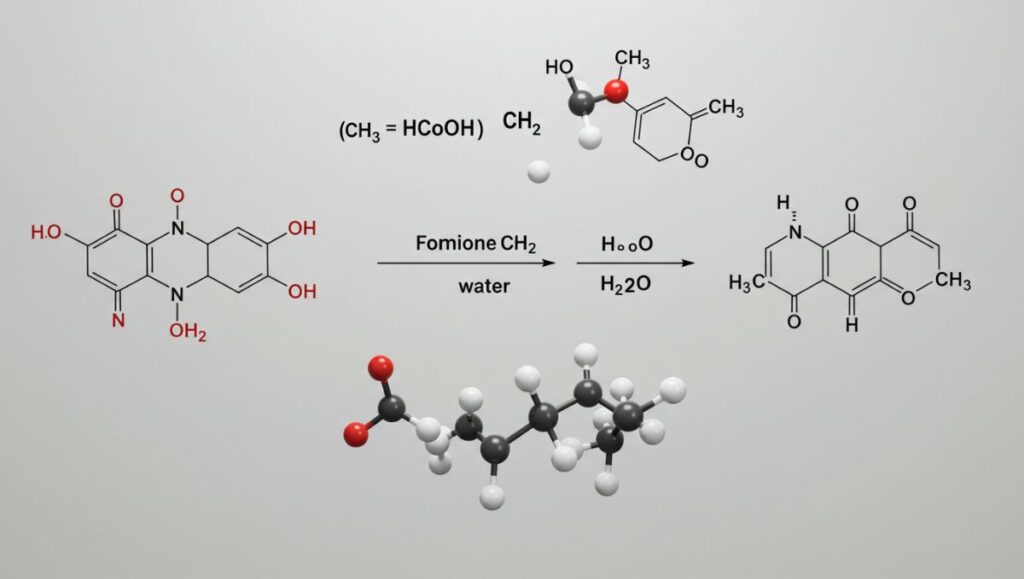Welcome to the fascinating world of chemical reactions! Today, we’re diving deep into a specific reaction that holds immense potential: hcooch ch2 h2o. This intriguing combination of compounds offers unique properties and applications across various industries. As we explore the nuances of this reaction, you’ll discover how it interacts with different catalysts, why it’s essential for sustainability efforts, and what future research is revealing about its capabilities. Join us on this journey as we uncover the chemical insights behind hcooch ch2 h2o and its impact on technology and society at large.
Explanation of the properties of the reaction
The chemical reaction involving hcooch ch2 h2o displays intriguing properties that set it apart in the realm of organic chemistry. This reaction is characterized by its ability to produce various intermediate compounds, which can lead to diverse end products.
One notable property of this reaction is its relatively low activation energy. This makes it favorable for industrial applications where efficiency is key. The reaction typically occurs under mild conditions, reducing the need for extreme temperatures or pressures.
Additionally, hcooch ch2 h2o exhibits polarity due to its molecular structure. This trait enhances solubility in polar solvents and opens doors for further reactions with other compounds.
Another interesting aspect lies in its selectivity; different catalysts can steer the outcome toward desired products, offering versatile pathways for synthesis. Understanding these properties paves the way for innovative uses across multiple sectors.
Applications of hcooch ch2 h2o in various industries
The compound hcooch ch2 h2o finds diverse applications across multiple industries. In the pharmaceutical sector, it plays a crucial role in synthesizing complex organic molecules. This versatility is key for developing new medications and therapies.
In agriculture, this chemical serves as an effective agent for improving soil quality. It aids in enhancing nutrient absorption, leading to healthier crops and better yields.
Additionally, the food industry utilizes hcooch ch2 h2o as a flavor enhancer and preservative. Its ability to maintain product freshness makes it invaluable.
Furthermore, the cosmetic industry benefits from its hydrating properties. Products infused with this compound often boast moisturizing qualities that appeal to consumers seeking skin care solutions.
Each application showcases how hcooch ch2 h2o can optimize processes while addressing specific needs across various fields.
The role of catalysts in enhancing the reaction
Catalysts play a pivotal role in the reaction of hcooch ch2 h2o, significantly enhancing its efficiency. By lowering the activation energy required for the reaction, they enable it to proceed at much faster rates.
Different types of catalysts can be employed depending on the desired outcome. Acidic or basic catalysts are often used to facilitate specific pathways in this chemical interaction. This selectivity is crucial when targeting particular products.
Moreover, catalysts can also influence the yield and purity of compounds produced during the reaction. This ensures that industries utilizing hcooch ch2 h2o achieve maximum effectiveness with minimal waste.
Their ability to remain unchanged after facilitating reactions makes them cost-effective and sustainable options in various applications. Thus, advancements in catalyst technology continue to drive research efforts aimed at optimizing these reactions even further.
Environmental impact and sustainability of using hcooch ch2 h2o
The environmental impact of hcooch ch2 h2o is a topic gaining traction among researchers and industry professionals. This chemical reaction offers a cleaner alternative to traditional processes that often produce harmful byproducts.
Using hcooch ch2 h2o can lead to reduced greenhouse gas emissions. The reaction’s efficiency means less energy consumption, which aligns with global sustainability goals.
Moreover, its applications span various sectors, from pharmaceuticals to food processing. In these areas, the use of this compound can minimize waste and enhance resource management.
Innovations in catalysis are also promising for improving the eco-friendliness of reactions involving hcooch ch2 h2o. By optimizing conditions and reducing reliance on toxic substances, we pave the way toward greener chemistry practices.
Investing in research focused on this chemical could unlock even more sustainable pathways forward. It points towards a future where industrial processes support rather than harm our planet.
Future potential and ongoing research on the reaction
Research into hcooch ch2 h2o is gaining momentum, revealing exciting possibilities. Scientists are exploring its potential as a sustainable chemical feedstock. This could revolutionize various industrial processes.
Ongoing studies focus on optimizing the reaction conditions. By fine-tuning temperature and pressure, researchers aim to enhance yield and efficiency. Such advancements may lead to cost-effective production methods.
Innovations in catalyst development also play a crucial role here. New materials can significantly accelerate reactions, making the use of hcooch ch2 more viable for large-scale applications.
Collaboration across disciplines is essential for unlocking this compound’s full potential. Chemists, engineers, and environmental scientists are joining forces to tackle challenges related to scalability and sustainability.
The future looks promising as new techniques emerge daily. With continued research efforts, we may soon see widespread adoption of this reaction in diverse industries.
Conclusion and how this chemical reaction can contribute to advancements in technology and society as a whole
The chemical reaction involving hcooch, ch2 h2o showcases a fascinating interplay of molecular dynamics that can significantly influence various sectors. As the understanding of this compound deepens, its potential applications continue to expand. From pharmaceuticals to renewable energy, the versatility of hcooch ch2 h2o opens doors for innovative solutions.
Advancements in catalyst technology promise to enhance reaction efficiency and selectivity. This is pivotal in minimizing waste and maximizing productivity across industries. Additionally, as research progresses, we may uncover new pathways that harness this compound’s properties for sustainable practices.
The environmental implications are equally noteworthy. By integrating ch2 h2o into green chemistry initiatives, companies can reduce harmful emissions while promoting eco-friendly production methods. The ongoing exploration into safer catalysts aligns with global goals for sustainability.
As scientists delve deeper into the complexities surrounding this chemical reaction, we stand on the brink of breakthroughs that could reshape our technological landscape. Harnessing these insights not only fosters innovation but also propels society toward more sustainable futures—where chemistry plays a crucial role in enhancing quality of life and protecting our planet’s resources for generations to come.







